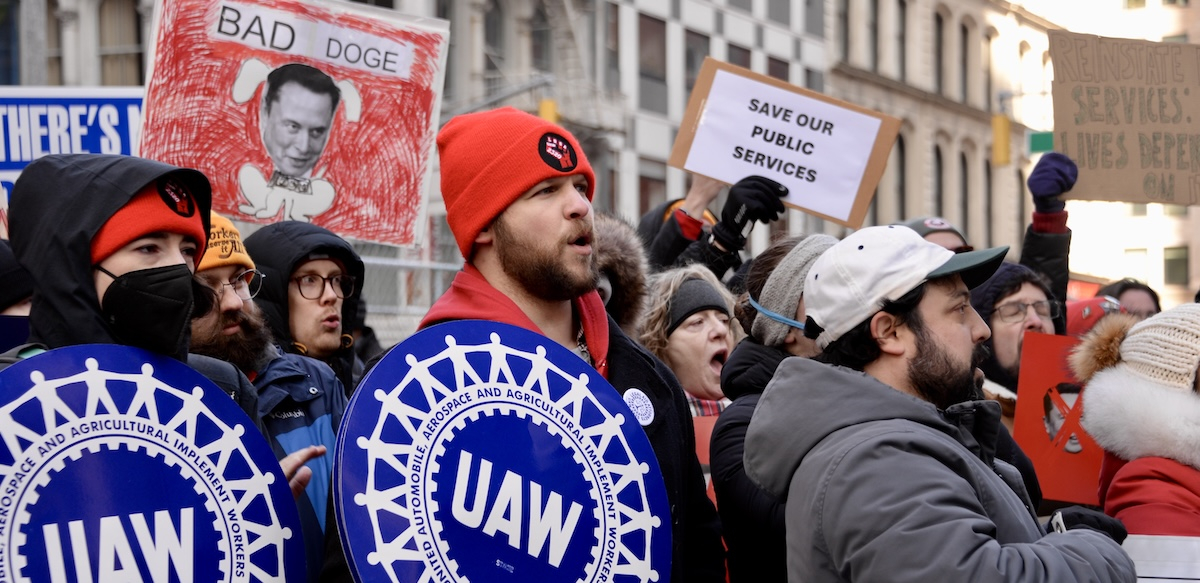Federal Unionists Say It’s Not Game Over, It’s Game On

The Federal Unionists Network is asking everyone to organize their coworkers and neighbors to demonstrate on April 5 at “Hands Off!” events around the country in response to the Trump administration’s claim to have ended nearly all collective bargaining for federal workers. But FUN seeks more than mobilization, and is providing tools for federal workers to organize their co-workers. Photo: Jenny Brown
A scrappy network of federal unionists is leading the response to the Trump administration’s attacks on their workplaces, including Trump’s March 27 order purporting to end union contracts covering most federal workers.
Where the Federal Unionists Network has led, union leaders have followed. In a Zoom event that drew 65,000 viewers, FUN got official support from all the significant federal unions for their bottom-up organizing approach to the Trump onslaught.
Federal worker unions are in the crosshairs because they are defending the jobs and agencies that Trump and Elon Musk have been trying to eliminate by illegally bypassing Congress and violating laws governing federal employment.
In February, FUN spearheaded a national “Save Our Services” day of action. Now it has created a rapid-response network, and is developing organizer trainings. It’s also sketching out a strategy to mobilize pressure against the Trump administration’s attacks by alerting the public about all the safeguards and services that are at risk.
“If we can connect those dots and make it clear it's about defending VA health care, it's about defending Social Security, it's about defending all the things that federal workers do, and that we're going to stand with them, the broader public, we can raise the political cost” of Trump’s attacks, said, said Chris Dols, a FUN founder and president of Federation of Technical and Professional Employees Local 98 at the Army Corps of Engineers.
But the key, FUN members argue, is building cohesion and fighting capacity within federal workplaces themselves.
On a recent FUN call Paul Osadebe, a member of American Federation of Government Employees Local 476 at Housing and Urban Development, urged workers to talk with their colleagues: “Just have a conversation and say, ‘Hey, the stakes are so high right now, but when we act collectively and not separately, and when we are not ruled by fear like they want us to be, we can build the power to stop all of this.’”
ORGANIZE AT WORK
FUN is emphasizing organizing at work because mobilizing those already involved has been insufficient. “We need to bring out much bigger numbers than we've seen so far,” said Dols. “Everybody can become an organizer, and in fact that's the only way we're going to be able to … raise the political cost high enough.”
In a call attended by 2,500 on March 30, FUN leaders emphasized talking to new people and convincing them to participate in the April 5 “Hands Off” rallies around the country. But FUN also stressed that workplace organizing needs to be for the long haul, and its success will rest on building bonds in the workplace.
“Listening is the most important thing you can do to open up an organizing conversation,” said Dols. “It's the organizing culture that you develop by developing those bonds between you and all your coworkers. That's where the power comes from.”
“I'm confident that by the end of this call you will know you are organizers and you'll be ready to go. And we're going to help you every step of the way,” said FUN call moderator Alissa Tafti, president of AFGE Local 2211 at the U.S. International Trade Commission.
CHAOTIC EVIL
Trump signed an executive order on March 27 that claimed to end collective bargaining for around one million federal workers. It’s the biggest attack on unions in generations.
That same day, the Justice Department sued AFGE in a federal court in Texas and the National Treasury Employees Union in Kentucky, seeking to cancel union contracts with workers at the departments of Treasury, Defense, Justice, Homeland Security, Veterans Affairs, and other agencies.
Unless it is stopped dead in its tracks, Trump’s federal union-busting may soon be copied by states. Public sector workers make up half of organized labor. If they lose their unions, the power of labor as a whole will be slashed—and private sector unions, too, will be in the crosshairs.
The new order followed months of brazen and illegal administration actions: the firing of probationary employees across the federal government; workplace invasions and lockdowns by teams from Musk’s “Department of Government Efficiency”; the cancellation of the union contract for 47,000 Transportation Security Administration workers (members of AFGE), and the attempted dismantling of USAID, the Department of Education, and the Consumer Financial Protection Bureau.
At the Department of Education, AFGE reported, every single union activist was laid off. At the Veterans Administration, workers said, managers sent an email instructing them to set up automatic deletion for emails coming from their union.
Like Trump’s order of March 7, which claimed to end the union at the Transportation Security Administration, the new order stops agencies from deducting dues for the union, and ends “official time”—paid time that stewards and officers use to handle grievances and enforce the contract.
AFGE and other unions were expecting some of these changes and have been signing workers up for direct dues as quickly as possible. Meanwhile, AFGE has seen an influx of new members. Unorganized shops, in some cases, have been clamoring to join the union.
SUING GOOD, BUT NOT ENOUGH
Unions have delayed some of the damage by suing. AFGE sued to stop the blanket firing of tens of thousands of probationary employees. Two federal judges separately agreed and ordered the workers hired back. Attempts to eliminate whole departments have been temporarily halted by lawsuits.
AFSCME and the American Federation of Teachers sued and blocked Elon Musk’s DOGE from data-stripping Social Security. In a temporary restraining order, the federal court ordered DOGE to “disgorge and delete” any data they had already scraped.
In response to the latest order, the National Treasury Employees Union has already filed suit, and other union lawsuits are in the works.

SUPPORT LABOR NOTES
BECOME A MONTHLY DONOR
Give $10 a month or more and get our "Fight the Boss, Build the Union" T-shirt.
But court victories are liable to be temporary, since Trump’s team will look for ways to make the same cuts while seeming to comply with the rulings. And of course the administration will almost surely appeal to the Supreme Court, where several justices are Trump acolytes.
NATIONAL SECURITY?
Trump’s executive order claims that “national security” is the reason about a million federal workers, from VA nurses to Forest Service workers, have to lose their collective bargaining rights. That is clearly a pretext, but federal workers say it’s also the opposite of reality: Often, it’s the union that is guaranteeing the public’s security and safety.
At the Veterans Administration, collective bargaining rights are vital to allow workers to speak out when something’s wrong, said Mark Smith, president of National Federation of Federal Employees Local 1 at the VA hospital in San Francisco.
“Those strong union contracts, they allow us to speak up without fear of retaliation, about unsafe staffing levels, right?” said Smith on a FUN call. “There are critical shortages of nurses and other health care professionals across the VA right now. Those union contracts allow us to speak up and advocate for safe patient care.”
Smith also said the union makes sure that even during a staffing shortage, workers are only doing jobs they’re actually trained to do.
Micah Niemeier-Walsh is vice president of AFGE Local 3840 at the Centers for Disease Control, which is facing drastic cuts. “Can you imagine if there was another pandemic, and CDC was understaffed and less prepared?” Niemeier-Walsh told FUN call participants. “These attacks impact the public as much as they impact federal employees.”
AFGE Local 3840 and other units across the CDC have been meeting regularly to strategize. As a result, they were able to come out united when the attacks came: “I feel so much more confident that we will be able to defeat this authoritarian attempt to take away our collective bargaining rights now that we are working together,” said Niemeier-Walsh.
NFFE has recent experience winning back rights. Members at the Department of Defense had their bargaining rights stripped away by the Bush administration in 2002. “Collective bargaining rights were gone by law for defense workers,” said NFFE President Randy Irwin. “We fought that legislation tooth and nail. We showed how hypocritical it was, how bad for society it was.” And eight years later, with a coalition of 40 unions, they won their rights back. “All those unions are still around working together today,” said Irwin.
Comments in FUN calls have ranged from fearful to defiant. Some have suggested sickouts, striking, or “All feds and supporters take over all roads in D.C. for a day.”
Others wrote in that for federal workers, striking is illegal: “Part of protecting the unions has to be following the rules so we don't make it easy to dismantle our unions,” one said.
“It is illegal, and there are real penalties to it,” another wrote. “If your union decides to withhold labor, it must be done collectively and by critical mass, and even then the penalties may be harsh.”
But the threat that their union would lose recognition if workers conduct job actions has lost some of its force if recognition has already been taken away. “They are not following the rules, why should we?” was a common reaction.
Some worried that their co-workers would be unreceptive to an organizing approach. “More than half of my co-workers voted for this [Trump]. I feel unable to talk about this with my coworkers,” one worker said. “What do I do?”
A FUN rep responded: “You can do it. You have us standing with you. I have been amazed at who I have gotten to join us. Start with one, start with a friend.”
“Never forget how incompetent and ridiculous this administration is,” another commented. “They can be defeated.”
‘BEEN HERE BEFORE’: FEDERAL UNIONS ARE HERE TO STAY
Unions formed and operated in the federal sector long before they won collective bargaining. The oldest, the National Federation of Federal Employees, represents 110,000 workers in the Departments of Agriculture, Interior, Defense, and Commerce. It was founded in 1917, but had no collective bargaining rights until the Kennedy Administration. The same is true of the American Federation of Government Employees, founded in 1932, which now represents 750,000 federal workers.
In 1962, Kennedy signed an executive order permitting limited collective bargaining for most federal workers in order to forestall a more labor-friendly bill then being considered by Congress. Collective bargaining rights were later confirmed by statute in 1978.
Federal workers have always faced severe limits. They have no right to strike. Wages and benefits are set by Congress, not negotiated in contracts. And no one is required to join a federal union or to pay dues. Still, federal unions are required to represent everyone in the workplace, member or not. In return for this obligation, federal workers negotiate official time in their contracts to fulfill those duties. All union officials are still employed by their agencies, though some may be on 100 percent official time.
Federal union affairs are governed by the Federal Labor Relations Authority. Trump summarily fired the head of the FLRA in February. A court has ordered her reinstated.
Workers at the Transportation Security Administration, founded after 9/11, were originally denied bargaining rights but won them by acting like a union. It took a decade, but they were finally able to vote for their union in 2011 and eventually secured a contract. High turnover and low morale characterized TSA jobs until the union won job protections and finally, in 2022, inclusion in the federal pay scale.





